Understand Just How Various Climate Condition Affect Your Roofing Installation To Assure An Effective Outcome
Understand Just How Various Climate Condition Affect Your Roofing Installation To Assure An Effective Outcome
Blog Article
Content Created By-Hartvigsen Donnelly
When it involves roof covering installments, the weather condition can make or break the job. Think of the irritation of taking care of materials that won't work together as a result of extreme heat or fighting slippery surface areas caused by unexpected rain. Recognizing the impact of climate condition on your roof project is essential for an effective result. So, let's explore exactly how different weather aspects can affect the top quality and toughness of your roofing installment, making sure a task well done.
Effect of Temperature on Roofing System Installation
When it concerns roof setup, temperature plays a critical function while doing so. The suitable temperature level for roof projects typically drops in between 45 and 85 degrees Fahrenheit. Extreme warm can create products like roof shingles to end up being as well pliable, resulting in potential damage during setup. On the other hand, chilly temperature levels can make materials fragile and susceptible to fracturing. It is very important to arrange roof setups during moderate temperature levels to make certain the best outcome.
During cooler weather condition, contractors may require to take added precautions such as making use of warmed tools or permitting products to heat up prior to installment.
On the other hand, heat might need job to be done previously or later in the day to avoid the peak temperatures. By thinking about the temperature level and its impacts on roof covering materials, you can assist guarantee a successful installation that will certainly withstand the elements for many years to come.
Impact of Precipitation on Roof Projects
Roofing jobs can be substantially affected by rainfall, influencing both the timeline and the high quality of the installment. Rainfall or snow can develop slippery problems, making it risky for roofing professionals to deal with a wet surface area. Additionally, dampness can compromise the adhesion of materials like roof shingles or underlayment, causing potential leakages or damages in the future.
If it rainfalls throughout a roof covering job, the water can leak into vulnerable locations, triggering hold-ups as the setup team have to await the roof covering to completely dry prior to continuing. simply click the next site can likewise promote the development of mold and mildew and mildew, additional threatening the honesty of the roofing.
To avoid these problems, it's suggested to schedule roof projects throughout drier periods or monitor the weather forecast closely to intend around any possible rainstorms. By taking precautions to operate in favorable weather, you can make certain a smoother and much more effective roofing system installation procedure.
Impact of Wind Speed on Installation Success
Throughout roofing installation, the rate of the wind plays an essential role in figuring out the success of the project. High wind rates can pose significant challenges to roofing contractors, possibly resulting in safety threats and quality issues. When wind rates surpass advised restrictions, it becomes tough to manage products, raising the danger of mishaps and damages to the roof covering products. Solid gusts can additionally influence the precision of dimensions and the precision needed for proper installation.
To guarantee an effective roofing system installment, it's vital to monitor and take into consideration wind rates. Preferably, roofing installment must occur on days with reduced to modest wind rates. This not just enhances the safety and security of the workers but additionally boosts the general high quality of the setup.
Roof tasks set up throughout calm weather conditions are most likely to be finished effectively and with less mistakes. By taking notice of wind rate forecasts and planning as necessary, you can aid make sure a smooth and effective roof covering setup procedure.
Conclusion
So, when it pertains to roof covering installment, remember to think about the weather to ensure an effective job. Optimal temperatures, completely dry conditions, and modest wind speeds are key aspects to prioritize for a smooth installation procedure. By scheduling your task throughout the most effective seasons and excellent climate condition, you can accomplish a sturdy and long-lasting roofing that will secure your home for several years ahead.
